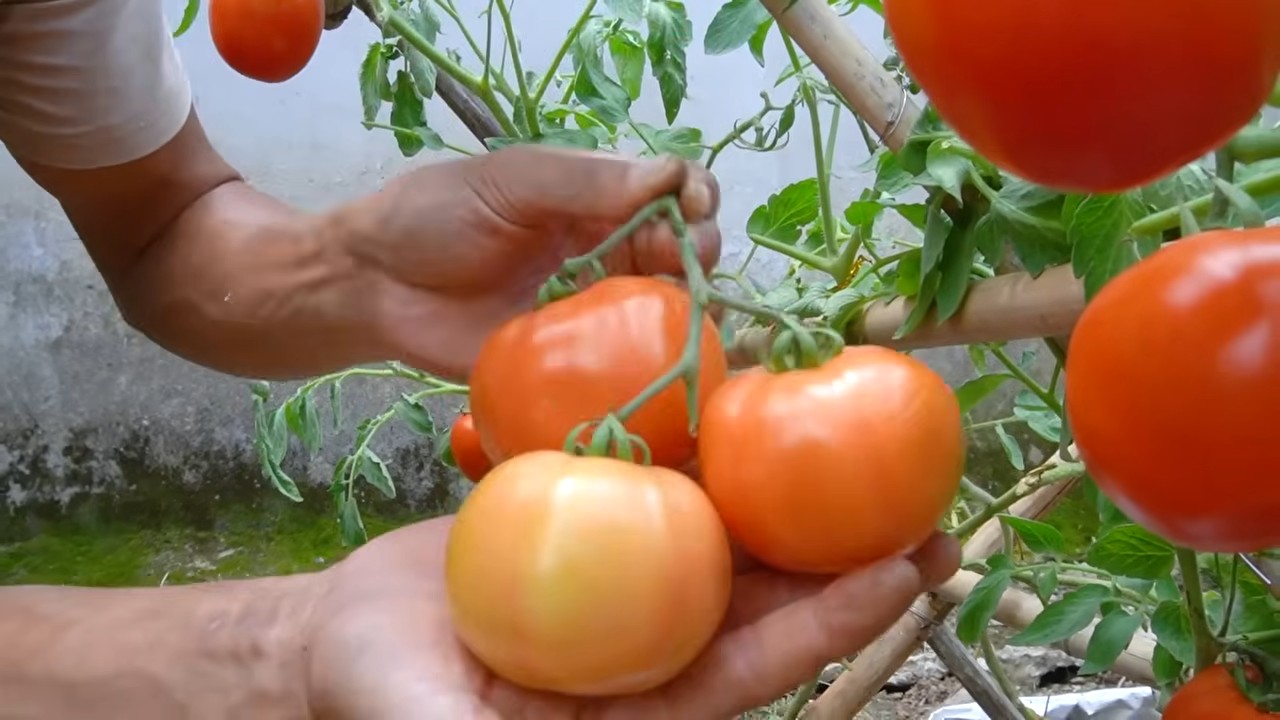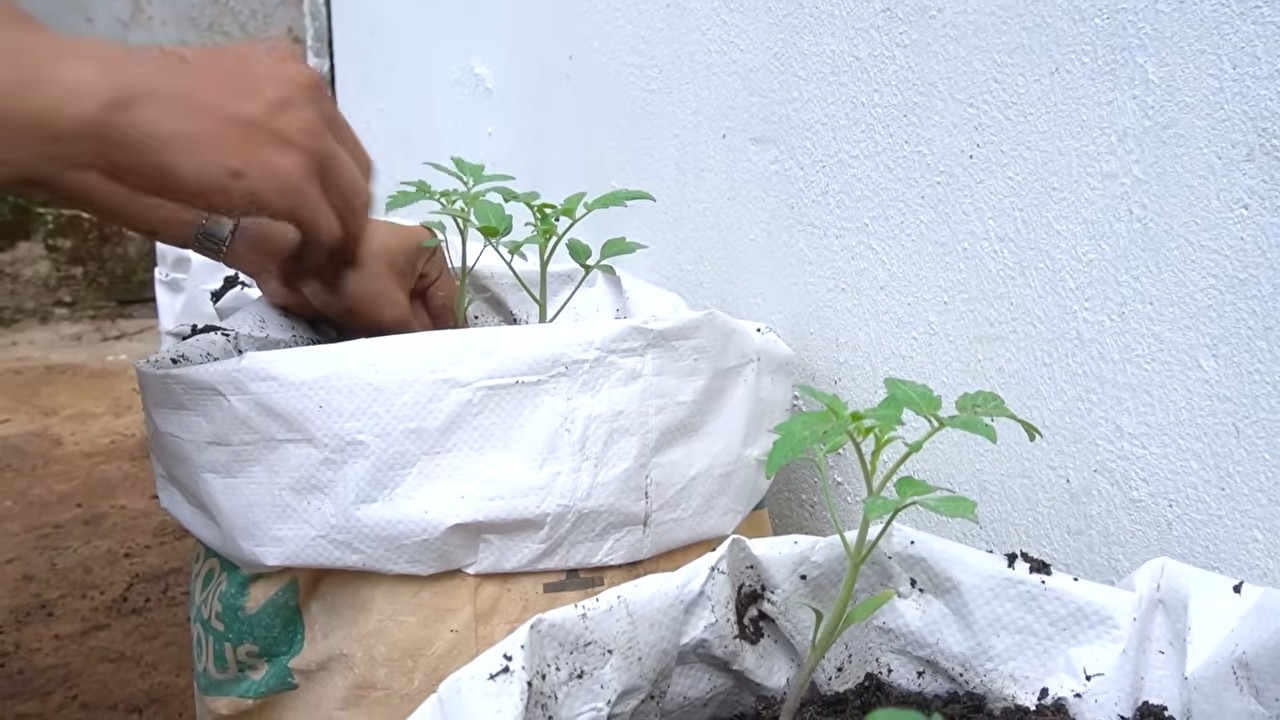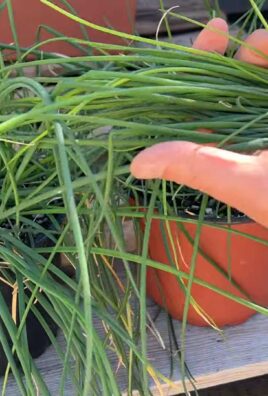Tomato harvest hack: Are you dreaming of baskets overflowing with juicy, sun-ripened tomatoes from your own garden? I know I am! But sometimes, getting those perfect tomatoes from vine to table can feel like a race against time, pests, and even the weather. That’s where a smart tomato harvest hack comes in handy, and I’m here to share my favorite with you!
For centuries, cultivating tomatoes has been a cherished tradition in many cultures. From the sun-drenched fields of Italy to the vibrant gardens of Mexico, the tomato has held a special place in our hearts and on our plates. But even with generations of knowledge, maximizing your tomato yield can still be a challenge.
Let’s face it, nobody wants to see their precious tomatoes succumb to blossom end rot, pests, or simply fall off the vine before they’re perfectly ripe. That’s why mastering a simple, effective tomato harvest hack is essential for any home gardener. This DIY trick will not only help you extend your harvest season but also ensure you’re enjoying the most flavorful, healthy tomatoes possible. So, grab your gardening gloves, and let’s dive into this game-changing technique that will transform your tomato-growing experience!

Tomato Harvest Hack: Ripen Green Tomatoes Indoors Like a Pro!
Hey there, fellow gardeners! Are you staring at a vine full of beautiful, plump, but stubbornly green tomatoes as the first frost looms? Don’t despair! I’m going to share my tried-and-true method for ripening those green gems indoors, so you can enjoy the fruits (or vegetables!) of your labor even after the growing season ends. This isn’t just about letting them sit on the counter; it’s about creating the optimal environment for them to turn that gorgeous shade of red (or yellow, or orange, depending on your variety!).
What You’ll Need:
Before we dive in, let’s gather our supplies. This is a pretty low-tech operation, which is one of the things I love about it!
* Your Green Tomatoes: Obviously! Choose tomatoes that are mature size, free from blemishes, bruises, or cracks. A little bit of yellowing or blushing is okay, but avoid any that are completely pale or have signs of rot.
* Cardboard Boxes or Shallow Trays: These will be our ripening containers. I prefer cardboard boxes because they offer darkness, which helps with the ripening process.
* Newspaper or Paper Towels: For lining the boxes and preventing moisture buildup.
* Apples or Bananas (Optional): These fruits release ethylene gas, a natural ripening agent. Adding one or two to your box can speed things up.
* A Cool, Dark, and Dry Place: A basement, garage, or even a closet works well. The ideal temperature is between 60-70°F (15-21°C).
* Soft Cloth or Gloves: To handle the tomatoes gently and avoid bruising.
Harvesting Your Green Tomatoes: A Gentle Approach
The way you harvest your tomatoes is crucial for successful indoor ripening. We want to avoid damaging them in any way.
1. Choose the Right Time: Ideally, harvest your tomatoes before the first frost. Even a light frost can damage them and make them unsuitable for ripening.
2. Handle with Care: Gently cup the tomato in your hand and twist it off the vine. Avoid pulling or yanking, as this can bruise the fruit.
3. Leave the Stem Attached: Leaving a small portion of the stem attached helps prevent rot and keeps the tomato fresher longer.
4. Inspect for Damage: As you harvest, carefully inspect each tomato for any signs of damage, such as bruises, cracks, or insect damage. Discard any damaged tomatoes, as they are unlikely to ripen properly and could spoil the rest.
5. Avoid Washing: Don’t wash your tomatoes before storing them. Washing can introduce moisture, which can lead to mold and rot. If they are particularly dirty, gently wipe them with a dry cloth.
Setting Up Your Ripening Station: Creating the Perfect Environment
Now that we have our tomatoes harvested, it’s time to create the perfect ripening environment. This is where the magic happens!
1. Prepare Your Boxes or Trays: Line your cardboard boxes or shallow trays with newspaper or paper towels. This will help absorb any excess moisture and prevent the tomatoes from rotting.
2. Arrange the Tomatoes: Place the tomatoes in the boxes or trays in a single layer, making sure they are not touching each other. This allows for good air circulation and prevents the spread of rot.
3. Add Ripening Agents (Optional): If you want to speed up the ripening process, add one or two apples or bananas to each box. These fruits release ethylene gas, which is a natural ripening agent.
4. Cover (Optional): You can loosely cover the boxes with newspaper or a cloth to create a darker environment. Darkness helps with ripening. However, make sure there is still some air circulation to prevent moisture buildup.
5. Label Your Boxes: Label each box with the date you harvested the tomatoes and the variety (if you have multiple varieties). This will help you keep track of which tomatoes are ripening and when.
Monitoring and Maintaining Your Tomatoes: Patience is Key!
Ripening tomatoes indoors is a waiting game. It can take anywhere from a few days to several weeks, depending on the variety, size, and maturity of the tomatoes, as well as the temperature and humidity of your ripening environment.
1. Check Regularly: Check your tomatoes every few days for signs of ripening. Look for changes in color, from green to yellow, orange, or red.
2. Remove Ripe Tomatoes: As soon as a tomato is ripe, remove it from the box and enjoy it!
3. Remove Any Spoiled Tomatoes: If you find any tomatoes that are starting to rot or mold, remove them immediately to prevent the spread of spoilage to the other tomatoes.
4. Adjust Temperature and Humidity: If the tomatoes are ripening too slowly, try moving them to a slightly warmer location. If they are ripening too quickly or starting to rot, try moving them to a cooler, drier location.
5. Rotate Tomatoes (Optional): Some people recommend rotating the tomatoes every few days to ensure even ripening. This is especially important if the tomatoes are not exposed to even light.
Troubleshooting: Addressing Common Issues
Even with the best intentions, things don’t always go according to plan. Here are some common issues you might encounter and how to address them:
* Tomatoes are Rotting: This is usually caused by too much moisture. Make sure your boxes are well-ventilated and that you are removing any spoiled tomatoes promptly. You can also try adding a desiccant, such as silica gel packets, to the boxes to absorb excess moisture.
* Tomatoes are Ripening Too Slowly: This could be due to low temperatures or a lack of ethylene gas. Try moving the tomatoes to a slightly warmer location or adding more apples or bananas to the boxes.
* Tomatoes are Ripening Unevenly: This could be due to uneven light exposure. Try rotating the tomatoes every few days to ensure even ripening.
* Tomatoes are Developing a Bland Flavor: Unfortunately, tomatoes ripened indoors often don’t have the same intense flavor as those ripened on the vine in the sun. However, you can still improve their flavor by storing them at room temperature for a few days after they ripen. This allows them to develop more flavor.
Alternative Ripening Methods: Exploring Your Options
While the cardboard box method is my go-to, there are a few other techniques you can try:
* The Paper Bag Method: Similar to the cardboard box method, but using a paper bag instead. This can be a good option if you only have a few tomatoes to ripen.
* The Window Sill Method: Place the tomatoes on a sunny windowsill. This can help them ripen faster, but be careful not to let them get too hot.
* The Hanging Plant Method: If you have a tomato plant that is still producing green tomatoes, you can try hanging the entire plant upside down in a cool, dark place. This can help the tomatoes ripen on the vine.
Enjoying Your Home-Ripened Tomatoes: Savoring the Flavor
Once your tomatoes are ripe, it’s time to enjoy them! While they might not be quite as flavorful as vine-ripened tomatoes, they are still a delicious and satisfying way to extend your gardening season.
* Store at Room Temperature: Store your ripe tomatoes at room temperature for a few days to allow them to develop more flavor.
* Use Them in Your Favorite Recipes: Use your home-ripened tomatoes in salads, sauces, soups, and other dishes.
* Share with Friends and Family: Share your bounty with friends and family. They’ll be impressed by your gardening skills!
I hope this guide helps you successfully ripen your green tomatoes indoors. Happy harvesting and happy eating! Remember, gardening is all about experimentation, so don’t be afraid to try different techniques and find what works best for you. And most importantly, have fun!

Conclusion
So, there you have it! This simple, yet incredibly effective tomato harvest hack is more than just a time-saver; it’s a game-changer for anyone with a thriving tomato patch. Imagine spending less time painstakingly picking each tomato individually and more time enjoying the fruits (or vegetables!) of your labor. This method minimizes bruising, reduces the risk of damaging the plant, and allows you to gather a significant portion of your harvest in one fell swoop. It’s a win-win-win!
But why is this tomato harvest hack a must-try? Because it addresses the common frustrations of tomato harvesting: the tediousness, the potential for damage, and the sheer amount of time it can consume, especially during peak season. This technique streamlines the process, making it more efficient and enjoyable. Think of it as a shortcut to tomato bliss!
Beyond the basic technique, there are several variations you can explore to tailor it to your specific needs and garden setup. For instance, if you have particularly delicate tomato varieties, you might consider lining your collection container with a soft cloth or towel to provide extra cushioning. Or, if you’re dealing with exceptionally large tomato plants, you might need to enlist a helper to hold the container while you gently shake the branches.
Another variation involves the timing of your harvest. While this hack works best when tomatoes are fully ripe, you can also use it to gather slightly less ripe tomatoes that you plan to ripen indoors. Simply adjust the force of your shaking to avoid dislodging any unripe fruit that isn’t quite ready to detach.
Don’t be afraid to experiment with different containers, too. While a large bucket or basket works well, you might find that a wide, shallow container is even better for preventing tomatoes from piling up and getting bruised. The key is to find what works best for you and your garden.
We wholeheartedly encourage you to try this tomato harvest hack during your next harvest. You’ll be amazed at how much time and effort it saves you. And more importantly, we want to hear about your experience! Share your tips, tricks, and variations in the comments below. Let’s create a community of tomato-loving gardeners who are all about making the most of their harvest. Did you find a particular container worked better than others? Did you discover a new way to adapt the technique to your specific tomato variety? We want to know! Your feedback will help other gardeners discover the joy and efficiency of this amazing tomato harvest hack. So, get out there, give it a try, and let us know what you think! Happy harvesting!
FAQ
What types of tomatoes does this harvest hack work best for?
This tomato harvest hack is generally effective for most tomato varieties, but it works particularly well for determinate tomatoes, which tend to ripen all at once. Indeterminate tomatoes, which produce fruit throughout the season, can also benefit from this technique, but you may need to make multiple passes through the garden to harvest the ripe tomatoes as they become ready. Cherry tomatoes and grape tomatoes are also excellent candidates for this method, as their small size and abundance make individual picking quite tedious. Larger heirloom varieties may require a bit more care and a gentler shaking motion to avoid bruising.
Will this method damage my tomato plants?
When performed correctly, this tomato harvest hack should not damage your tomato plants. The key is to use a gentle shaking motion, rather than a violent one. The ripe tomatoes should detach easily from the vine with minimal effort. Avoid pulling or yanking on the branches, as this can cause damage. If you notice any broken branches or stems, it’s a sign that you’re being too rough. Also, ensure your plants are healthy and well-supported, as weakened plants are more susceptible to damage.
What if some of my tomatoes are not quite ripe?
If some of your tomatoes are not quite ripe, you have a couple of options. You can either leave them on the vine to ripen further and repeat the harvest hack in a few days, or you can carefully pick them individually and ripen them indoors. To ripen tomatoes indoors, place them in a paper bag with a ripe banana or apple. The ethylene gas released by these fruits will help to speed up the ripening process. Store the bag in a cool, dark place, and check the tomatoes daily for ripeness.
What kind of container should I use for collecting the tomatoes?
The best container for collecting tomatoes during this harvest hack is one that is large, sturdy, and easy to handle. A large bucket, basket, or even a plastic tub will work well. Consider lining the container with a soft cloth or towel to provide extra cushioning and prevent bruising, especially if you’re harvesting delicate tomato varieties. The size of the container will depend on the size of your tomato plants and the expected yield. A container that is too small will require frequent emptying, while a container that is too large may be difficult to maneuver.
How do I know when my tomatoes are ripe enough to harvest using this method?
The best way to determine if your tomatoes are ripe enough to harvest is to look for a deep, even color and a slight softness to the touch. Ripe tomatoes should also detach easily from the vine with a gentle tug. Avoid harvesting tomatoes that are still green or hard, as they will not ripen properly off the vine. The specific color and texture will vary depending on the tomato variety, so it’s helpful to familiarize yourself with the characteristics of your particular tomatoes.
Can I use this method for other types of fruits and vegetables?
While this harvest hack is specifically designed for tomatoes, it may also be effective for other types of small, easily detached fruits and vegetables, such as berries or grapes. However, it’s important to consider the fragility of the produce and adjust the shaking motion accordingly. For more delicate fruits and vegetables, a gentler shaking or tapping motion may be necessary to avoid bruising or damage. Always test the method on a small area first to ensure that it doesn’t harm the plants or the produce.
What if I don’t have a large garden? Can I still use this hack?
Absolutely! This tomato harvest hack is just as effective for small gardens and container gardens as it is for large gardens. In fact, it may be even more beneficial for smaller gardens, as it can help you to quickly and efficiently harvest your tomatoes without taking up too much time or space. Simply adjust the size of your collection container to suit the size of your garden and the number of tomato plants you have.
How can I prevent bruising when using this tomato harvest hack?
To minimize bruising, ensure your tomatoes are fully ripe before harvesting, as they are less susceptible to damage when they are at their peak ripeness. Line your collection container with a soft cloth or towel to provide extra cushioning. Use a gentle shaking motion, rather than a violent one. Avoid overfilling the container, as this can cause the tomatoes to pile up and get bruised. And handle the tomatoes carefully when transferring them from the container to your kitchen.




Leave a Comment